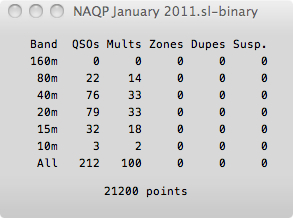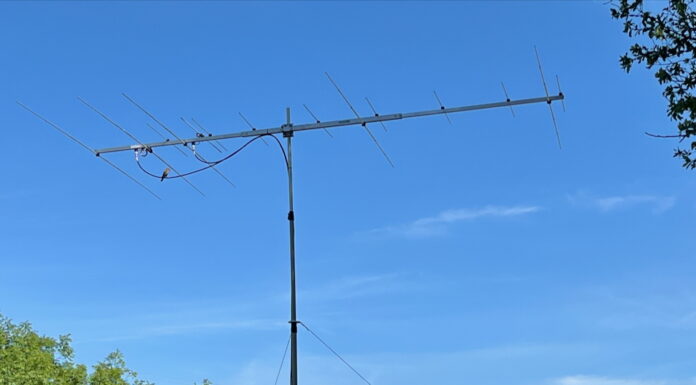
The image at the right is the screen capture of my score from the logging software. This is easily the highest score that I’ve ever reached in any contest. It shows that I contacted 212 stations and 100 multipliers. My previous best was 182 stations in a 48 hour contest.
The key for me was first the format of this contest. It is only in North America and stations can operate with no more than 100 watts of power. That really helps when you’re like me and trying to breakthrough the crowd with 5 watts of power. In the big international contests, there are a high percentage of people running full legal power of 1,500 watts.
The second big difference was the Elecraft P3 panadapter that I added to the station in December. With it, I could literally see the stations and tune swiftly from one to the next. In addition, when a band was dead or dying I could see the entire band with one sweep and go to the few stations that were operating, or move on to another band without wasting my time. Also, later in the contest on 80 meters when it was noisy and I was tired, I could move from one strong signal to the next and skip over the low level signals, who typically can’t hear me to begin with.
I operated 7 hours of the contest. You are allowed to operate a total of 10 hours out of the twelve. I quit around 9 PM, just because I was tired and had reached a point of diminishing returns on 80 meters. Next time, I’ll try to get my score still higher. It was a lot of fun this time because nearly everyone I called came back to me within two to three calls.
The third factor in my higher scores was the logging software that I used. I installed Skookum Logger, a Mac contest logging software. It was well set up for the contest and greatly eased the entry of station information. It also expedited the output of scoring information. Plus, it kept me informed of my score, which was a big motivator at times.
Overall, I’m still deciding what approach to take with contest logging software. At this point I’m considering purchasing a refurbished Windows PC for around $200 to $300 and a flat screen monitor. This would allow me to run N1MM logger or WriteLog as well as a host of ham radio Windows applications. I’ve also thought about a used Mac Mini, but those run $500 to $600. That would allow me to continue with MacLogger DX as my main logging software and I’ve really enjoyed the Skookum Logger. I have pretty much determined that my next step in this journey is the WinKeyer — which would be a common need whether I go with Windows and Mac for the dedicated ham shack computer.
I hope you’ve learned a bit about ham radio contesting. Or if you’re an old pro at contesting, please leave your comments.
73, Jim








